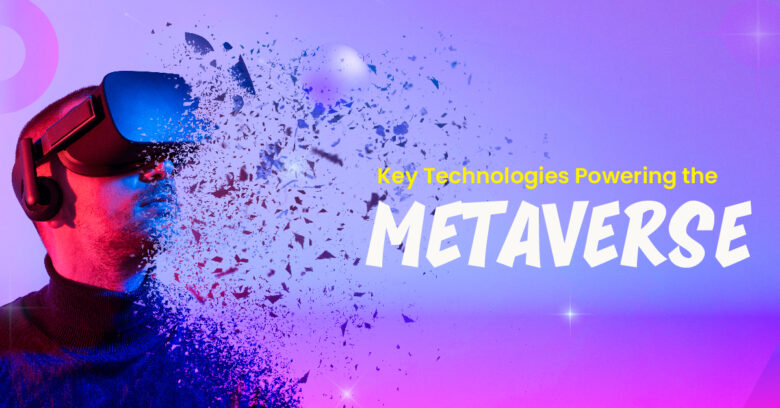We expect the metaverse, a developing concept, to transform how we work, interact, and play in a virtual world. Various technologies operate behind the scenes to create this enthralling digital world. These technologies are the basis for creating an interconnected, seamless experience that lets users communicate with 3D environments as well as digital assets and with each other in real-time. Without these essential technological advancements, the metaverse could be just a futuristic concept. Understanding the technology that powers the metaverse lets us see the way this digital future is becoming a reality
Virtual Reality as the Gateway to Immersion:
Virtual reality, often referred to as VR, is one of the most important technologies that drive the metaverse. VR allows users to immerse themselves in fully digital worlds, where computers create everything they see and hear. With the aid of VR headsets like the Oculus Quest, PlayStation VR, or HTC Vive, users can feel a sense of being that is real. Al. The immersive experience is vital in making the metaverse more engaging. From virtual social spaces and games to virtual classrooms and offices, VR is setting the conditions for users to experience and engage with metaverses engagingly.
Augmented Reality: Bridging the Digital and Physical Worlds
While VR provides a completely digital experience, augmented reality, or AR, improves the physical world by overlaying digital content on the physical environment. AR is accessible through tablets, smartphones, and specialized glasses like Microsoft HoloLens and Magic Leap. This technology lets users experience and engage with virtual objects while staying in the present. AR is particularly beneficial in combining real-world activities with metaverse functions, for example, like shopping online within physical retail stores, participating in games in public areasandas collaborating on digital projects at real-world offices. AR adds a further dimension of flexibility to the metaverse, connecting the physical and digital worlds seamlessly.
AI Enhancing Realism and Personalization:
Artificial intelligence, also known as AI, plays an essential role in making the world more responsive, intelligent, and personalized. AI algorithms can design real-life Non-Player Characters (NPCs), analyze user behavior, and aid in decision-making in digital environments. It also facilitates advanced speech recognition and translation of languages to make global interactions easier to access. AI can enhance avatars by improving their facial expressions and movements, making them appear and behave like real human beings. Furthermore, AI is responsible for moderating and organizing content, detecting bad behaviors, and generating dynamic learning experiences. As the metaverse expands, AI ensures it remains effective, enjoyable, and friendly for users.
Blockchain Providing Ownership and Security:
Blockchain technology is at the heart of various areas of the metaverse, particularly in transactions and ownership in digital form. Blockchains are a decentralized digital ledger that tracks transactions across various computers, which makes them safe and transparent. It lets users possess virtual assets, like land, art, and avatars, using non-fungible currencies (NFTs). These NFTs verify the authenticity and possession of digital objects, which allows for a real-time virtual economy. Blockchain also supports cryptocurrencies that are commonly utilized to be the main currency in the metaverse. The technology allows users to purchase or sell their goods and services without the need for central banks or other institutions, which creates an open and secure environment.
5G Networks Enabling Real-Time Connectivity:
The metaverse requires speedy and stable internet connections, and 5G technology can meet this need. 5G networks have much faster speeds and less latency than prior generations, which is vital for live-action interactions in real-time environments. If you are going to virtual performances, playing multiplayer games, or holding discussions in an online workplace, 5G ensures a smooth and continuous experience. The high bandwidth of 5G also allows for the use of more mobile devices. This is vital as more people join the metaverse. In the absence of 5G technology, the giant demand for data in the metaverse could be difficult to handle, particularly for wireless and mobile devices.
Cloud Computing Supporting Massive Virtual Worlds:
The metaverse’s infrastructure is heavily dependent on cloud computing. Cloud computing services offer the processing and storage capacity required to run sophisticated virtual environments without having to own powerful hardware. Platforms such as Amazon Web Services (AWS), Microsoft Azure, and Google Cloud offer scalable resources capable of handling all aspects of rendering 3D images and storing personal data of users. Cloud computing allows real-time collaboration as well as large multiplayer systems and guarantees that digital assets can be accessed at any time. As the metaverse grows, cloud technology will ensure that it is robust, scalable, and reliable for the millions of users.
3D Modeling and Digital Twins: Creating Realistic Environments
To make the world exciting, 3D modeling is used to create everything from landscapes and buildings to avatars and other accessories. Developers and artists use special software to create realistic models that viewers can interact with and explore. We use digital twins, virtual replicas of real-world objects and environments, to simulate settings and test various scenarios. They aren’t only for entertainment; they are also employed in the fields of manufacturing, healthcare, and education to display data, plan operations, and create immersive simulations. The precision and clarity offered through 3D modeling and the digital twins make the metaverse appear more real and practical.
Edge Computing: Reducing Latency and Enhancing Experience
Although cloud computing can be crucial in the storage of data and its processing, edge computing brings computing close to users. Through processing information at an “edge” of the network–near the device or user’s location–edge computing decreases latency and increases performance. This is particularly important when it comes to VR as well as AR applications, in which even tiny delays can ruin the user experience. Edge computing guarantees smoother gaming and faster loading times, and more stable interactions. Edge computing is integrated with 5G to provide an ultra-high-performance metaverse that is immediate and real-time, even on remote or mobile devices.
Internet of Things: Connecting the Physical and Virtual
IoT, also known as the Internet of Things, or IoT, involves connecting physical objects to the internet so that they can exchange and receive information. Within the virtual world, IoT can help bridge the gap between the physical and digital worlds. For instance, smart devices can communicate in virtual worlds, which allows real-world actions to impact the digital outcome. Wearable devices can track the movements of users and biometrics, increasing the realism of avatars and interactivity. Smart home systems may eventually be controlled via virtual control rooms inside the metaverse. Integration of IoT into the virtual world offers many new opportunities in terms of ease, personalization, and control.
Conclusion:
The metaverse is not fueled by one technology but by a vast array of innovations that work together to provide immersive, interconnected experiences. From virtual reality and augmented reality to blockchain, AI, and 5G, every technology is an important piece of the puzzle. As the advancement of these technologies continues and becomes more advanced, the metaverse will be more accessible, exciting, and impactful. For entertainment or business, education, or social interaction, technology, the innovations driving this metaverse have shaped the direction of future digital living. Recognizing and understanding the power of these technologies is essential to unlocking the maximum potential of this exciting new frontier.
FAQs:
1. Which is the single most significant technology in the metaverse?
There is no single most crucial technology. It is fueled by a blend of technologies such as VR, blockchain, AR, AI, and 5G, which all come together to provide the best experience.
2. Do I require a VR headset to enter the Metaverse?
But not always. Certain metaverse platforms can be accessible via smartphones or computers; however, the VR headset gives an immersive experience.
3. How can blockchain be of help with the metaverse?
Blockchain guarantees the secure ownership of assets, facilitates cryptocurrency transactions, and ensures the trust of decentralized environments.
4. Does the metaverse exist exclusively reserved for gamers?
The metaverse is being designed for a myriad of uses, such as education, virtual meetings, online shopping, and social networks.
5. Will the technology behind the metaverse become accessible shortly?
As technology adoption rises and the pace of innovation increases, the cost of technology such as VR headsets and high-speed internet is likely to decrease as time passes.




